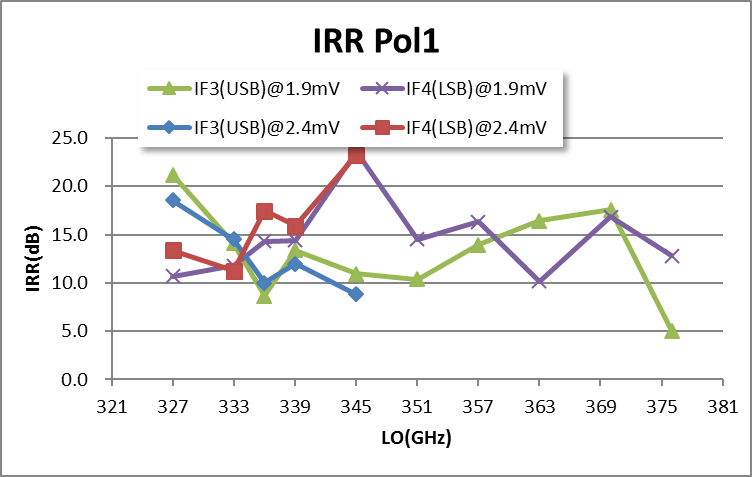Instrumentation Overview
DASH 345
February 20, 2015
A cartridge-type dual-polarization side-band separating (2SB) mixer receiver for 350 GHz band, DASH345, is available from 2015.
Specifications
- Tunable LO frequency range: 327 GHz to 370 GHz
- IF frequency range: 4.0 GHz to 8.0 GHz
- Observable frequency range (LO frequency range +/- IF center frequency): 321 GHz to 376 GHz. Please consult us in advance if you want to observe a line beyond the frequency range.
- Receiver temperature


Figure 1: Receiver temperature as a function of LO frequency
- Image rejection ratio (IRR): 15 dB typical.


Figure 2: Image rejection ratio as a function of LO frequency
- Polarization: two linear polarization (P0 and P1), but polization observations are not available.
- Expected system noise temperature (Tsys): Assume a SSB system noise temperature of Tsys = 250 K at 345 GHz at EL ~ 60. Note that this is for an averaged atmospheric condition in winter (i.e., for zenith opacity at 220 GHz of ~0.05 or precepitable water vapor, PWV, of ~1 mm). It can be highly variable depending on the atmospheric conditions and observing frequency. See Fig. 3 for atmospheric transparency as a function of frequency.
| Mixer | Npolar#1 | Npix | fLO (GHz) | fobs (GHz) | IF (GHz) | typical IRR |
TRX (2SB) | Tsys (SSB) #2 |
|---|---|---|---|---|---|---|---|---|
| sideband-separating SIS mixer | 2 | 1 | 327-370 | 321-376 | 4.0-8.0 | 15 dB | 100-120 K | 250 K |
CATS 345
Feb. 10, 2012
A cartridge-type side-band separating (2SB) mixer receiver for 350 GHz band, CATS345, is not available from 2015.
Specifications (Feb. 10, 2012)
- Tunable LO frequency range: 330 GHz to 366 GHz
- IF frequency range: 4.5 GHz to 7.0 GHz (receiver IF range is 4.0 to 8.0 GHz, but it is limited by a filter at IF optical transmission section.)
- Observable frequency range (LO frequency range +/- IF center frequency): 324 GHz to 372 GHz. Please consult us in advance if you want to observe a line beyond the frequency range.
- Image rejection ratio (IRR): 15 dB typical.
- Polarization: single linear polarization only.
- Expected system noise temperature (Tsys): Assume a SSB system noise temperature of Tsys = 250 K at 345 GHz at EL ~ 60. Note that this is for an averaged atmospheric condition in winter (i.e., for zenith opacity at 220 GHz of ~0.05 or precepitable water vapor, PWV, of ~1 mm). It can be highly variable depending on the atmospheric conditions and observing frequency. See Fig. 3 for atmospheric transparency as a function of frequency.
| Mixer | Npolar | Npix | fLO (GHz) | fobs (GHz) | IF (GHz) | typical IRR |
TRX (2SB) | Tsys (SSB) #1 |
|---|---|---|---|---|---|---|---|---|
| sideband-separating SIS mixer | 1 | 1 | 330-366 | 324-372 | 4.5-7.0 | 15 dB | 100-120 K | 250 K |
- Note #1: This is a value expected at 345 GHz at EL ~ 60 deg under a typical condition (zenith opacity at 220 GHz = 0.05).
Receiver tuning
It requires about 10 minutes for receiver tuning when you start observations or change your observing frequency. Attenuators for LO and IF powers and room temperature absorber will be adjusted remotely by observers.
Atmospheric transparency

Figure 3: Atmospheric transparency as a function of frequency, for PWV = 1 mm.
